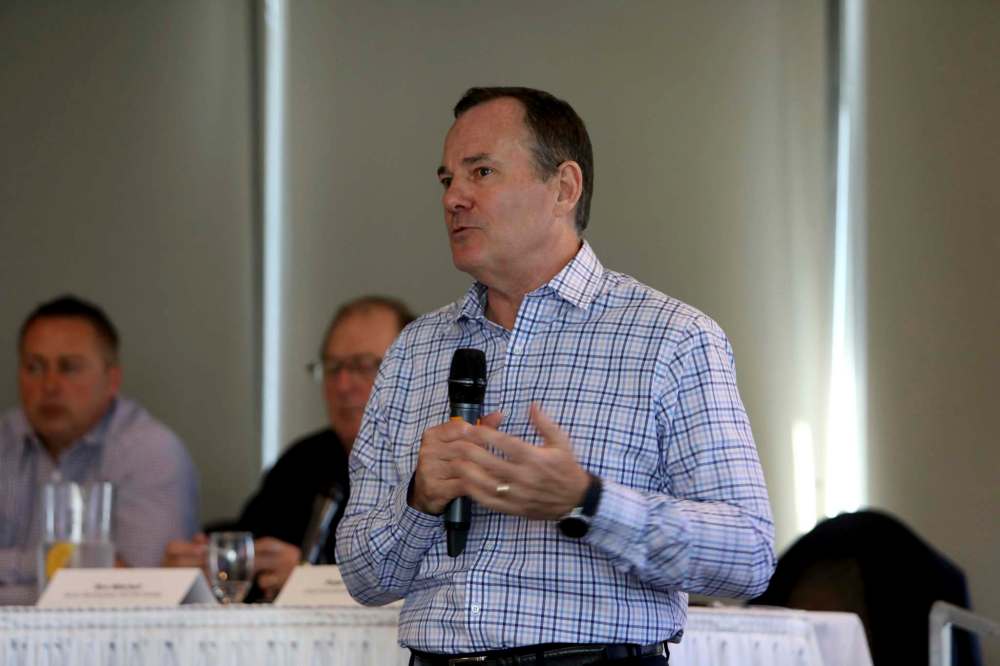Time ripe to take over rail line
Advertisement
Read this article for free:
or
Already have an account? Log in here »
To continue reading, please subscribe:
Monthly Digital Subscription
$0 for the first 4 weeks*
- Enjoy unlimited reading on winnipegfreepress.com
- Read the E-Edition, our digital replica newspaper
- Access News Break, our award-winning app
- Play interactive puzzles
*No charge for 4 weeks then price increases to the regular rate of $19.00 plus GST every four weeks. Offer available to new and qualified returning subscribers only. Cancel any time.
Monthly Digital Subscription
$4.75/week*
- Enjoy unlimited reading on winnipegfreepress.com
- Read the E-Edition, our digital replica newspaper
- Access News Break, our award-winning app
- Play interactive puzzles
*Billed as $19 plus GST every four weeks. Cancel any time.
To continue reading, please subscribe:
Add Free Press access to your Brandon Sun subscription for only an additional
$1 for the first 4 weeks*
*Your next subscription payment will increase by $1.00 and you will be charged $16.99 plus GST for four weeks. After four weeks, your payment will increase to $23.99 plus GST every four weeks.
Read unlimited articles for free today:
or
Already have an account? Log in here »
Hey there, time traveller!
This article was published 18/07/2017 (3060 days ago), so information in it may no longer be current.
Omnitrax is a quirky company, and one of its quirkiest qualities is an insistence that a health and safety briefing precede the start of any meeting, interview or news conference.
And so it was on Tuesday when government officials, First Nations leaders and journalists gathered in a downtown hotel ballroom to get the first detailed update from Omnitrax on the damage to the Hudson Bay Railway from spring flooding.
An Omnitrax official worked his way through a health and safety checklist: designating the person officially charged with calling 911; identifying the location of the nearest AED device; instructions on what to do if a fire alarm sounded; the location of the nearest washrooms; and a warning to all those involved to be very careful about chairs and briefcases when walking around the room.

There are two main conclusions that can be drawn from this highly unusual prelude to a news conference.
That Omnitrax has a hypersensitivity about health and safety that borders on paranoia. Or, that this is a company that is very, very deliberate and methodical in everything it says and does.
The latter theory works very well as an explanation for the mind-numbingly detailed briefing that Omnitrax delivered this week. In short, northern Manitoba’s most important transportation link has suffered an unprecedented level of damage from the worst spring-thaw floods in the last half-century.
That information was really not new; first-hand accounts confirmed weeks ago the horrendous level of damage. The new information came in the form of two critically important statements from Omnitrax chief commercial officer Peter Touesnard.
First, that it would cost between $20 million and $60 million to repair the railway.
And second, that Omnitrax is not prepared to cover any of those costs.
“Because we have determined the rail line lacks commercial viability and now (faced) with millions of dollars of damage… we can’t justify the resources necessary to repair the line,” Touesnard said.
Touesnard’s admission really confirms what most informed observers have suspected for weeks now — the company had been trying to sell the railway and the Port of Churchill even before the flood waters came. It seemed unlikely Omnitrax would spend money repairing the line above, perhaps, the normal cost of maintenance.
However, having now publicly admitted it won’t pay for any repairs, Omnitrax has put the ball squarely in the court of the federal and provincial governments.
Ottawa and the province have not played well together on this file. However, with this latest salvo from the Denver-based Omnitrax, both governments need to present a united front.
Omnitrax clearly wants to be paid to leave Manitoba, but its refusal to pay for repairs could be, if necessary, used as a sign it wants to abandon the line, opening the door for government to take over. That is, however, the nuclear option and one that should not be employed lightly.
Should taxpayers just cover the cost of the repairs? In its briefing, Omnitrax provided ample reason to be suspicious about the company’s intentions going forward.
First, the range of the cost of repairs is hilariously broad. Omnitrax did a good job of describing the many variables, including the availability of materials, rolling stock, specialized equipment and an experienced contractor. Still, the range of estimate suggests — even after six weeks of detailed analysis — that it is being cagey about the true cost of the repairs.
A similar concern exists with the estimate of the time to complete repairs. After spending nearly an hour detailing the horrendous damage, Omnitrax said the work could be done in 60 days. It was a shocking claim given the company’s hyperbole.
And then there is the schedule that Omnitrax has set for repairs. With assessment done, Omnitrax said it needs another six weeks to complete a cost estimate and then award a contract. That would mean work on the line would start no sooner than Sept. 1 and be completed by Oct. 31.
That is also, coincidentally, the end of the shipping season. With the rail line out of commission, basic necessities such as groceries, diesel fuel and gasoline have been coming in by freighter to the port of Churchill. Once the shipping season concludes, prohibitively expensive air freight would be the only option for resupply.
Omnitrax spent weeks assessing the damage and then presented a plan Tuesday that really leaves government only days to make a decision about whether to pony up to save a transportation link that Manitoba surely cannot afford to lose.
What is government to do in a scenario like this? Oddly enough, Omnitrax may have unwittingly provided a way forward.
Touesnard said the railway should be viewed as a “public utility.” And he is probably right. With up to $60 million in repairs pending, it does not have commercial value. It is a transportation asset, no different really than a highway, although in strictly economic terms, the railway is much less costly.
For comparison, let’s look at what you can buy for $60 million, the upper end of the repair estimate from Omnitrax.
If we spent that entire amount on the 800-kilometre-long Hudson Bay Railway, it would work out to a cost of $75,000 per kilometre.
For the same $60 million, you could build about 36 kilometres of double-lane highway.
That equation, plus the refusal of Omnitrax to invest in repairs, could be viewed as an opportunity for the federal and provincial governments to regain control over the future of northern Manitoba. The only question is whether they have the political will to seize that opportunity.
dan.lett@freepress.mb.ca
Omnitrax Technical Briefing Presentation

Dan Lett is a columnist for the Free Press, providing opinion and commentary on politics in Winnipeg and beyond. Born and raised in Toronto, Dan joined the Free Press in 1986. Read more about Dan.
Dan’s columns are built on facts and reactions, but offer his personal views through arguments and analysis. The Free Press’ editing team reviews Dan’s columns before they are posted online or published in print — part of the our tradition, since 1872, of producing reliable independent journalism. Read more about Free Press’s history and mandate, and learn how our newsroom operates.
Our newsroom depends on a growing audience of readers to power our journalism. If you are not a paid reader, please consider becoming a subscriber.
Our newsroom depends on its audience of readers to power our journalism. Thank you for your support.
History
Updated on Wednesday, July 19, 2017 10:36 AM CDT: Adds Omnitrax report






